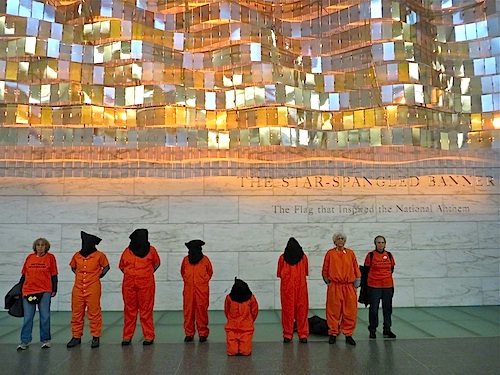Plea Deals in Federal Court Mooted for Guantánamo Prisoners in Next Year’s National Defense Authorization Act
 I wrote the following article for the “Close Guantánamo” website, which I established in January 2012, on the 10th anniversary of the opening of Guantánamo, with the US attorney Tom Wilner. Please join us — just an email address is required to be counted amongst those opposed to the ongoing existence of Guantánamo, and to receive updates of our activities by email.
I wrote the following article for the “Close Guantánamo” website, which I established in January 2012, on the 10th anniversary of the opening of Guantánamo, with the US attorney Tom Wilner. Please join us — just an email address is required to be counted amongst those opposed to the ongoing existence of Guantánamo, and to receive updates of our activities by email.
Last week there was an interesting development in relation to President Obama’s hopes of closing Guantánamo, when the Senate Armed Services Committee announced that it had included a provision in its version of next year’s National Defense Authorization Act, which, as Charlie Savage reported for the New York Times, would allow Guantánamo prisoners to “plead guilty to criminal charges in civilian court via video teleconference,” and would also allow them to be “transferred to other countries to serve their sentences.”
Last November, a number of lawyers sent a letter to the Justice Department, which the New York Times discussed here, in which they “express[ed] interest in exploring plea deals by video teleconference — but only in civilian court, not military commissions.”
Lawyers for six prisoners said that they “may wish” to negotiate plea deals — Abu Zubaydah, the “high-value detainee” for whom the CIA’s torture program was developed, Abu Faraj al-Libi, another “high-value detainee,” Sanad al-Kazimi, a Yemeni who recently went before a Periodic Review Board, Abd al-Rahim Ghulam Rabbani, a Pakistani, Abdul Latif Nasser, the last Moroccan in the prison, and Soufian Barhoumi (aka Sufyian Barhoumi), an Algerian whose PRB is taking place on May 24. As Savage described it, the letter also “said several others are interested, and that Majid Khan, who has pleaded guilty in the [military] commissions system but has not been sentenced, would like to plead again, in civilian court.” Read the rest of this entry »
Playing Politics with the Closure of Guantánamo
 I wrote the following article for the “Close Guantánamo” website, which I established in January 2012 with US attorney Tom Wilner. Please join us — just an email address is required to be counted amongst those opposed to the ongoing existence of Guantánamo, and to receive updates of our activities by email.
I wrote the following article for the “Close Guantánamo” website, which I established in January 2012 with US attorney Tom Wilner. Please join us — just an email address is required to be counted amongst those opposed to the ongoing existence of Guantánamo, and to receive updates of our activities by email.
Supporters of the “Close Guantánamo” campaign have long been aware that the very existence of the “war on terror” prison at the US naval base in Guantánamo Bay, Cuba is an affront to all notions that the United States respects justice and the rule of law, and we remember that as the closure of the prison becomes, yet again, an undignified game of political football, with Congress continuing to erect obstacles to the release of prisoners and the transfer of anyone to the US mainland for any reason, and the Obama administration trying to come up with a workable plan for the prison’s closure.
Although Congress, the week after the 9/11 attacks, passed a law — the Authorization for Use of Military Force — that purports to justify the detention of prisoners without charge or trial at Guantánamo, and the Supreme Court ruled in June 2004 that the government can hold them until the end of hostilities, this thin legal veneer has persistently failed to disguise the fact that everything about Guantánamo is wrong.
The Bush administration established the prison to be beyond the reach of the US courts, and for nearly two and a half years the men — and boys — held there had no rights whatsoever. In a second decision delivered in June 2004, the Supreme Court ruled that they had habeas corpus rights, a decision that allowed lawyers into the prison, breaking the veil of secrecy that had shrouded the prison for all that time, enabling torture and other forms of abuse to take place. Even so, it was not until June 2006 that the Supreme Court, in another ruling, reminded the administration that no one can be held without rights, and that Common Article 3 of the Geneva Conventions, which prohibits torture and “humiliating and degrading treatment,” applied to everyone in US custody. Read the rest of this entry »
Finally, President Obama Vetoes Defense Bill That Contains Onerous Guantánamo Restrictions
 I wrote the following article for the “Close Guantánamo” website, which I established in January 2012 with US attorney Tom Wilner. Please join us — just an email address is required to be counted amongst those opposed to the ongoing existence of Guantánamo, and to receive updates of our activities by email.
I wrote the following article for the “Close Guantánamo” website, which I established in January 2012 with US attorney Tom Wilner. Please join us — just an email address is required to be counted amongst those opposed to the ongoing existence of Guantánamo, and to receive updates of our activities by email.
Last week, for only the fifth time in his Presidency, Barack Obama vetoed a bill sent for his approval by Congress. The bill in question was the draft of next year’s National Defense Authorization Act, which provides funding for the military, but which, for several years now, has also been used by Republicans to impose restrictions on the president’s ability to release prisoners from Guantánamo — as well as an absolute ban on bringing any prisoner to the US mainland for any reason.
In a Veto Message on October 22, President Obama wrote, “I am returning herewith without my approval H.R. 1735, the ‘National Defense Authorization Act for Fiscal Year 2016.'” He added that “the bill would, among other things, constrain the ability of the Department of Defense to conduct multi-year defense planning and align military capabilities and force structure with our national defense strategy, impede the closure of the detention facility at Guantánamo Bay, and prevent the implementation of essential defense reforms.”
On Guantánamo, President Obama wrote, in further detail: Read the rest of this entry »
The Path to Closing Guantánamo
 I wrote the following article for the “Close Guantánamo” website, which I established in January 2012 with US attorney Tom Wilner. Please join us — just an email address is required to be counted amongst those opposed to the ongoing existence of Guantánamo, and to receive updates of our activities by email.
I wrote the following article for the “Close Guantánamo” website, which I established in January 2012 with US attorney Tom Wilner. Please join us — just an email address is required to be counted amongst those opposed to the ongoing existence of Guantánamo, and to receive updates of our activities by email.
On Saturday, six Yemenis were freed from Guantánamo, and resettled in Oman, bringing the prison’s population down to 116 men, the lowest total it has been since the first few months of the prison’s operation back in 2002. I wrote about the release of the men here, and amended the details of our prisoner list here, and, in response to the releases, I thought it would also be useful to follow up by looking at where we stand with President Obama’s long-promised mission to close the prison.
President Obama made his promise to close Guantánamo on his second day in office, pledging to close it within a year. Since failing to keep the promise, he has sporadically stated again his desire to see the prison closed — most notably two years ago, when a prison-wide hunger strike prompted him to promise to resume releasing prisoners, after a period of nearly three years in which releases had almost ground to a halt, because of opposition in Congress and the president ‘s refusal to expend political capital overcoming those obstacles.
In April, as I wrote about here, the Washington Post reported, as I paraphrased it, that all the men approved for release in Guantánamo — at the time 57 out of the 122 men still held — would be “freed by the end of the year, and, if Congress proves obstructive, the Obama administration might close the facility before the end of Obama’s presidency by unilaterally moving the remaining prisoners to the US mainland.” I added, however, that, realistically, “it might be wisest to view these suggestions as the administration stating its best-case scenario.” Read the rest of this entry »
White House Threatens to Veto War Provisions and Restrictions on Closing Guantánamo in Defense Bill
 Two weeks ago, when the “peace dividend” that should follow the death of Osama bin Laden was hijacked by cynical lawmakers intent on using bin Laden’s death to expand the “War on Terror” by revising its founding document, the Authorization for Use of Military Force, passed by Congress the week after 9/11, and also seeking to endorse torture and to defend Guantánamo, I addressed these baleful developments in a hard-hitting article, entitled, No End to the “War on Terror,” No End to Guantánamo.
Two weeks ago, when the “peace dividend” that should follow the death of Osama bin Laden was hijacked by cynical lawmakers intent on using bin Laden’s death to expand the “War on Terror” by revising its founding document, the Authorization for Use of Military Force, passed by Congress the week after 9/11, and also seeking to endorse torture and to defend Guantánamo, I addressed these baleful developments in a hard-hitting article, entitled, No End to the “War on Terror,” No End to Guantánamo.
Earlier today I also cross-posted a memorandum sent to the House Armed Services Committee by the ACLU, the Center for Constitutional Rights, Human Rights First and 20 other organisations, urging the Committee not to support the reckless and unjustifiable expansion of Presidential war powers, as contained in a section of the 2012 National Defense Authorization Act (NDAA).
That article also included a link to an ACLU campaign page where US citizens can write to their elected representatives asking them to oppose these vile plans by warmongers drunk on their addiction to permanent war. I hope that anyone concerned will do so, as it is extremely important, but I’d also like to remind readers of other sections inserted into the NDAA, which deal with Guantánamo, as I also mentioned in No End to the “War on Terror,” No End to Guantánamo. Read the rest of this entry »
Rights Groups Tell Congress: Vote No to Dangerous New “War on Terror” Provisions
 Note: You can write to your elected representative asking them to “Say No to Worldwide War” via this ACLU page here.
Note: You can write to your elected representative asking them to “Say No to Worldwide War” via this ACLU page here.
Following the death of Osama bin Laden, as I explained in my article, No End to the “War on Terror,” No End to Guantánamo:
[T]here is a perfect opportunity for the Obama administration to bring to an end the decade-long “War on Terror” by withdrawing from Afghanistan and closing the prison at Guantánamo Bay, Cuba.
The justification for both the invasion of Afghanistan (in October 2001) and the detention of prisoners in Guantánamo (which opened in January 2002) is the Authorization for Use of Military Force, passed by Congress on September 14, 2001, just three days after the 9/11 attacks. […]
With bin Laden’s death, the route should now be open for the President to assert that he has used “all necessary and appropriate force against those nations, organizations, or persons he determines planned, authorized, committed, or aided the terrorist attacks that occurred on September 11, 2001” [as mandated by the AUMF] and to get out of the unwinnable morass that is the ongoing occupation of Afghanistan. Read the rest of this entry »












 Who's still at Guantánamo?
Who's still at Guantánamo?
